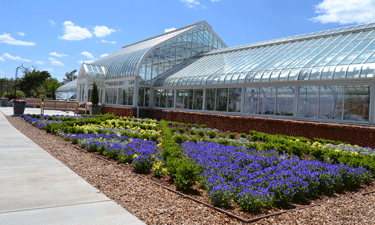 Municipality: Oklahoma City
Municipality: Oklahoma City
Population: 620,000
Year Agency Founded: 1980
Annual Operating Budget: $33.4 million
Director: Douglas R. Kupper
Full-time Employees: 197
Part-time/Seasonal Employees: 300-plus
Essential Information
One-hundred fifty-two parks, 21,000 acres of undeveloped and developed parkland (including three recreational lakes), five golf courses, 141 athletic fields, 113 playgrounds, 81 miles of multi-use trails/pathways, 10 community/recreation centers, two senior centers, 17 spraygrounds, three community pools, two family aquatic centers, one 32,000-square-foot extreme skate park, four skate courts, 67 tennis courts, three disc golf courses, 11 fishing lakes, one nature center, one botanical garden, two arboretums, one municipal fish hatchery, two outdoor amphitheaters, Civic Center Music Hall (a 287,000-square-foot performing arts center) and the Rose State College Hudiburg Chevrolet Performing Arts Center (an 80,000-square-foot performance facility), one river corridor and one urban waterway.
City on the Rise
With leadership that focuses on prosperity and the wellness of its citizens, Oklahoma City is setting itself up as one of the 21st century’s metropolitan success stories. The Oklahoma City Parks and Recreation Department plays a large part in that achievement. In an October 2012 Parks & Recreation magazine article, Oklahoma City Mayor Mick Cornett spoke of his experiences as a youth growing up playing sports in local parks, and doesn’t discount the need for more open spaces and wellness opportunities for citizens. Under Cornett’s leadership, Oklahoma City’s Parks and Recreation Department has seen $89 million in General Obligation bond funding for capital improvements, and more than $280 million worth of investment in the MAPS 3 initiative (a one-penny, pay-as-you-go sales tax program now in its third iteration) that cites new capital projects including senior wellness centers, improved multi-use trails, a whitewater rafting and kayak center and a brand-new, 70-acre downtown park.
When complete, the new MAPS 3 park will connect the city’s busy downtown corridor to the Oklahoma River, a 7-mile expanse of waterway bordered by parkland and multiple recreation areas, including four parks, 13 miles of multi-use trails and a dynamic, nationally-acclaimed boathouse district that offers rowing, kayaking and other adventure sports to the public.
These types of programs are just fine with Oklahoma City Parks and Recreation Director Douglas R. Kupper, CPRP, who took the helm of the agency in May 2014. “Oklahoma City has a lot going for it in terms of forward-thinking leadership,” says Kupper. “Citizens aren’t afraid to invest in infrastructure, and don’t underestimate the importance of keeping young home-grown talent where it belongs. Parks are a natural extension of that, especially in terms of community health and wellness. It’s my belief that parks and recreation programs are the No. 1 health and wellness provider to any city, both in physical and mental wellness.”
Emphasizing Community Health
In January 2015 the City Council cited community wellness as one of its top six priorities, which aligns seamlessly with the priorities set forth in the recently completed Parks and Recreation Master Plan (playokc). The parks master plan is part of the city’s new comprehensive plan that emphasizes citizen wellness through increased sidewalks, more active open spaces, a stronger recreation model and added multipurpose trails and on-street commuter bikeways.
For the Oklahoma City Parks and Recreation Department, wellness includes a renewed focus on health and exercise programs in its Recreation Division. Staff is bringing new ideas to the table for adult sports leagues and fitness classes in recreation centers. The Oklahoma City Community Foundation, a private community funding arm and advocacy group, awarded the agency with a $22,000 grant to support nutrition and exercise education for adults over 55 years old. The department is also collaborating with the Oklahoma City Community Foundation to establish a Parks Foundation in support of parks, recreation and cultural services.
Key Partnerships and Areas of Focus
Oklahoma City Parks and Recreation enjoys partnership agreements with more than 190 nonprofit agencies, neighborhood and homeowner groups, as well as local foundations. One of these partnerships is with Wilderness Matters, whose $1 million investment at Martin Nature Park through the Integris Jim Thorpe Rehabilitation Courage Trail is paving the way for individuals with disabilities to experience nature in a meaningful way through an accessible trail, interpretive signage and integrated smartphone application. Each of these collaborations benefits the community in sweat equity and private contributions, allowing taxpayer dollars to be stretched. In 2014 alone, the monetary value of these partnerships was more than $10 million.
Conservation is also a key priority, with park planners integrating rain gardens, xeriscaping and other sustainable landscape techniques in their park design, in addition to preventative maintenance in forestry and grounds management. A culturally diverse organization, the demographic makeup of Oklahoma City Parks and Recreation staff exceeds the demographics of the local community in racial and gender equality, providing a broad scope of services to citizens among each income and socioeconomic level.
All of these efforts lend themselves to greater success in key measures of the city’s Leading For Results (LFR) strategic business plan, which adds up to citizen confidence and a willingness to invest in new growth for parks and recreation, creating a future as bright as the city itself.
Walt Bratton, CPRP, is Assistant Director of the Oklahoma City Parks and Recreation Department.

